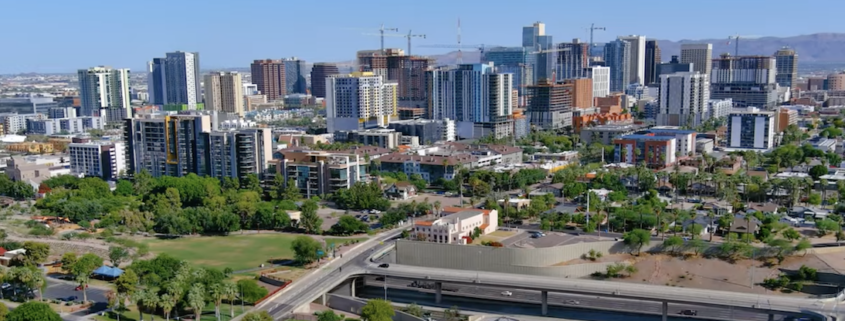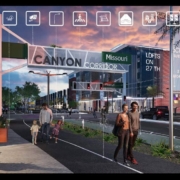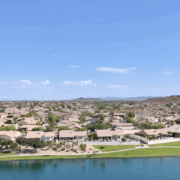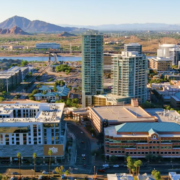Phoenix Solidifies Spot As 5th Largest US City; Other AZ Cities Show Population Surges | Living In Phoenix Arizona
PHOENIX SOLIDIFIES SPOT AS 5TH LARGEST US CITY; OTHER AZ CITIES SHOW POPULATION SURGES
LIVING IN PHOENIX, ARIZONA
Phoenix Solidifies Spot As 5th Largest US City; Other AZ Cities Show Population Surges
New figures released Thursday by the U.S. Census Bureau show that Phoenix has reinforced its position as the nation’s fifth largest city, registering the nation’s eighth-largest numerical population increase between 2023 and 2024.
The Census Bureau’s Vintage 2024 estimates for cities and towns found that several cities in and around the Valley were among national leaders in population growth over one-year and four-year time spans.
Phoenix added 16,933 new residents between July 1, 2023, and the same date in 2024, for a final population figure of 1,673,164. That amounted to 1% growth, ranking Phoenix No. 729 out of cities with populations of 20,000 or more for percentage growth over a one year period, actually far below the growth rate of other Valley cities.
Queen Creek took the top spot in Arizona when it came to year-over-year percentage growth. It ranked No. 23 nationally with its 8.1% population increase, growing by 6,286 people between 2023 and 2024 for a new population of 83,781.
When looking at longer-term growth, Queen Creek was also tops for Arizona. The East Valley city’s 40.8% population gain between April 1, 2020 and July 1, 2024 was the 13th highest in the nation, and Maricopa was next at No. 21 with a 31.8% gain. Only 14 cities had growth of 40% or more and 25 cities had growth of 30% or more during that time period.
East Valley cities’ reputation for growth is certainly nothing new. Just last month, an analysis from StorageCafe found a 133% population growth in Queen Creek between 2014 and 2023, along with high 10-year growth rates for Gilbert, Chandler and Mesa among larger cities.
Despite the general trend of growth, not every city in Arizona saw growth. In the one-year measure, Fountain Hills, Chandler and Tempe saw population declines of 0.1%, 0.1% and 0.3%, respectively. Looking at population change over four years, Fountain Hills, Sierra Vista and Florence each declined by 0.5%, 1.4%, 9%, respectively.
Pinal County Cities See Percentage Growth Gains
According to the Census Bureau’s one-year growth data released May 15, just a few spots down were Pinal County cities Casa Grande and Maricopa, which ranked at Nos. 27 and 28 for 7.7% and 7.4% growth, respectively (with populations of 68,927 and 76,654). After that was Queen Creek’s neighbor Apache Junction at No. 32 with 7.2% growth to reach 44,309.
Four more cities made the Census Bureau’s top 100 list for one-year percentage growth, showing that the highest-growth areas are situated at the extremities of Arizona’s urban centers. They are:
- No. 42 Marana (near Tucson), 6% (62,380)
- No. 58 Goodyear, 5.4% (118,186)
- No. 60 Surprise, 5.3% (167,564)
- No. 85 Buckeye, 4.5% (114,334)
The four-year population percentage growth picture in Arizona tells a similar story, with the same batch of cities appearing in slightly different order. Here’s how they broke down after Queen Creek and Maricopa:
- No. 28 Casa Grande, 28.5%
- No. 38 Buckeye, 24.9%
- No. 45 Goodyear, 22.9%
- No. 60 Marana, 20.2%
- No. 89 Surprise, 17.1%
- No. 103 Apache Junction, 15%
Nationally, coming in ahead of Phoenix as the country’s largest cities were New York City, Los Angeles, Chicago and Houston. Three of those — New York, L.A. and Houston — were top three for one-year numeric growth. Also coming in ahead of Phoenix for numeric growth were San Antonio, Fort Worth, Charlotte and Chicago.
The Census Bureau noted that Southern and Western cities had the highest growth rates, but also noted that more cities in the Northeast and Midwest saw their first population increases in recent years.
“Many population growth rates reversed or saw major changes between 2023 and 2024,” said Crystal Delbé, a statistician in the Census Bureau’s Population Division, in a statement. “Cities in the Northeast that had experienced population declines in 2023 are now experiencing significant population growth, on average. In fact, cities of all sizes, in all regions, showed faster growth and larger gains than in 2023, except for small cities in the South, whose average population growth rate remained the same.”
Cities with populations fewer than 5,000 grew by 0.3% on average, compared with average growth rates of 1.0% for those with populations of 5,000 to 9,999; 1.1% for those with populations of 10,000 to 49,999; and 1.0% for those with populations of 50,000 or more, the Census Bureau said.
– more at bizjournals.com
Thinking about investing in Phoenix real estate? Have a property to sell in Arizona? Tell us what you’re searching for. Connect with us to buy, sell, or lease multifamily, residential and commercial real estate in Phoenix, and across Arizona. Let’s work together.
Natan Jacobs, Vestis Group
Call: 602-281-6202
Email: Info@Vestis-Group.com












